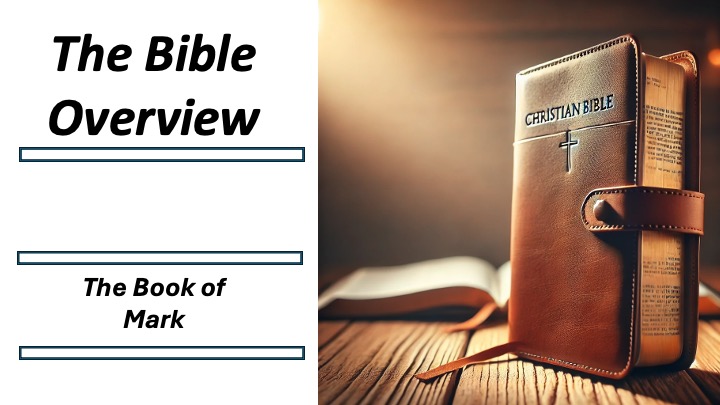Bible Overview Mark
Mike Ervin

Gospel
of Mark: Overview
Authorship
Traditional View:
• Traditionally attributed to John Mark, a companion of Peter and Paul (Acts
12:12, 1 Peter 5:13).
• Early church fathers (Papias, Irenaeus) state that Mark wrote down Peter’s
eyewitness accounts of Jesus’ life.
Modern Scholarly View:
• Most scholars accept Mark as the author but recognize that his Gospel may
have been edited over time.
• Some argue for anonymous authorship, with the title added later.
• Considered the earliest Gospel, serving as a source for Matthew and Luke in
the Synoptic Problem.
Date of Authorship
• Traditional View: Written before 70 AD, possibly 50s–60s AD, based on early
references to Peter’s teachings.
• Modern View: Most scholars date it 65–75 AD, possibly after Nero’s
persecution and before or just after the destruction of the Temple (70 AD).
Intended Audience
• Primarily Gentile Christians, likely in Rome, suggested by explanations of
Jewish customs (Mark 7:3-4).
• Addresses persecution and suffering, which fits a Roman context.
Major Themes
1. Jesus as the Suffering Servant – Mark emphasizes Jesus’ suffering and
sacrificial role (Isaiah 53).
2. The Messianic Secret – Jesus often commands people to keep His identity
hidden (Mark 1:34, 8:30).
3. Jesus’ Authority & Miracles – Demonstrates His power over nature,
demons, and illness.
4. Discipleship & the Cost of Following Jesus – Disciples often
misunderstand Jesus’ mission, highlighting the difficulty of true discipleship.
5. The Kingdom of God – Urgent call to repentance and faith in Jesus.
Chapter-by-Chapter Summary
I. Jesus’ Ministry Begins (Ch. 1–3)
• Ch. 1 – John the Baptist, Jesus’ baptism, temptation, and early miracles.
• Ch. 2 – Healing the paralytic, controversy over the Sabbath.
• Ch. 3 – Jesus appoints the Twelve Apostles.
II. Teachings & Miracles (Ch. 4–8)
• Ch. 4 – Parables of the Sower, Mustard Seed.
• Ch. 5 – Jesus calms the storm, heals Legion and Jairus’ daughter.
• Ch. 6 – Feeding of 5,000, Jesus walks on water.
• Ch. 7–8 – More miracles; Peter’s confession (“You are the Christ”).
III. Journey to Jerusalem (Ch. 9–13)
• Ch. 9 – The Transfiguration.
• Ch. 10 – Teachings on divorce, riches, and servanthood.
• Ch. 11–12 – Triumphal Entry, cleansing the Temple, greatest commandment.
• Ch. 13 – Olivet Discourse (prophecy of the end times).
IV. Passion & Resurrection (Ch. 14–16)
• Ch. 14 – Last Supper, Gethsemane, betrayal.
• Ch. 15 – Trial, crucifixion, and burial.
• Ch. 16 – Resurrection (ending disputed in some manuscripts).